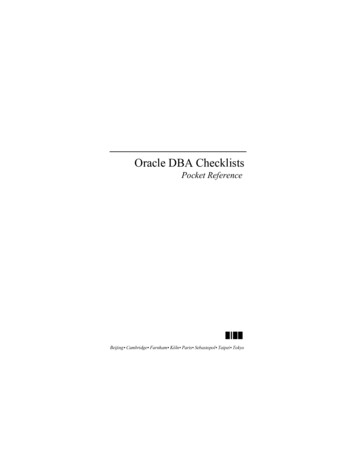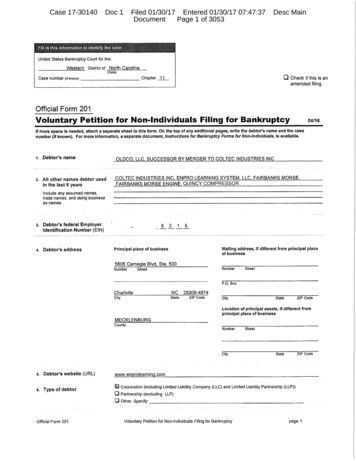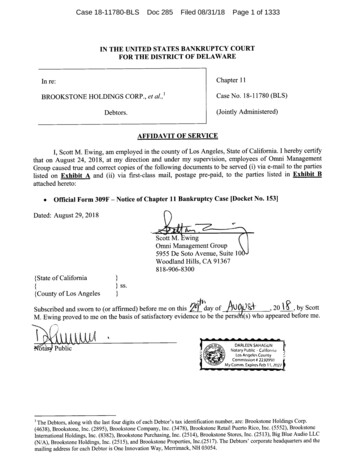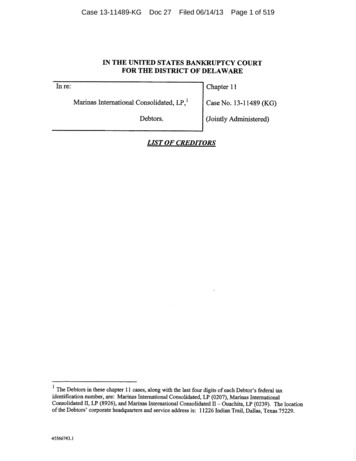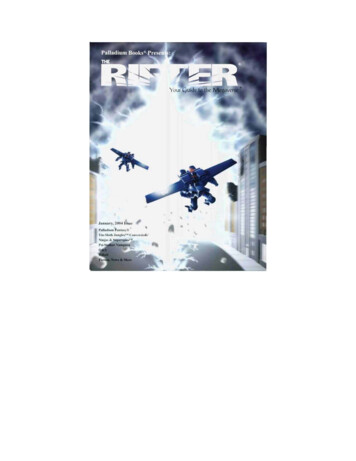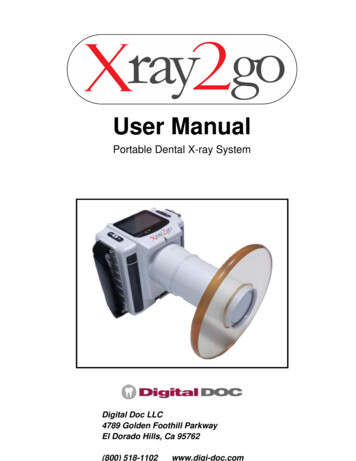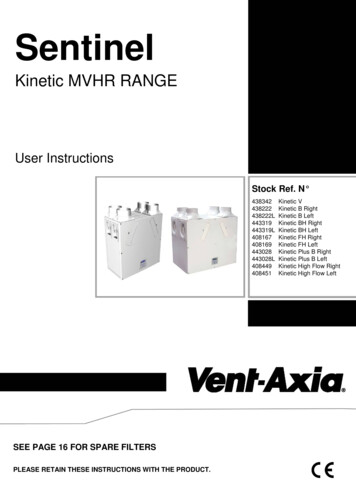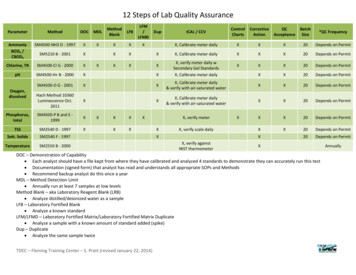
Transcription
12 Steps of Lab Quality MDAmmoniaBOD5 /CBOD5SM4500‐NH3 D ‐ 1997XXXXXSM5210 B ‐ 2001XXXXChlorine, TRSM4500‐Cl G ‐ 2000XXXXpHSM4500‐H B ‐ 2000XXSM4500‐O G ‐ 2001XXHach Method 10360Luminescence Oct.2011XXPhosphorus,totalSM4500‐P B and E ‐1999XTSSSM2540 D ‐ 1997XSett. SolidsSM2540 F ‐ 1997TemperatureSM2550 B ‐ 2000Oxygen,dissolvedXXXXXXDupXICAL / ize*QC FrequencyX, Calibrate meter dailyXXX20Depends on PermitX, Calibrate meter dailyXXX20Depends on PermitXXX20Depends on PermitXX20Depends on PermitX, Calibrate meter daily& verify with air‐saturated waterXX20Depends on PermitX, Calibrate meter daily& verify with air‐saturated waterXX20Depends on PermitXX20Depends on PermitXX20Depends on Permit20Depends on PermitX, verify meter daily wSecondary Gel StandardsX, Calibrate meter dailyX, verify meterXX, verify scale dailyXXXX, verify againstNIST thermometerXDOC – Demonstration of Capability Each analyst should have a file kept from where they have calibrated and analyzed 4 standards to demonstrate they can accurately run this test Documentation (signed form) that analyst has read and understands all appropriate SOPs and Methods Recommend backup analyst do this once a yearMDL – Method Detection Limit Annually run at least 7 samples at low levelsMethod Blank – aka Laboratory Reagent Blank (LRB) Analyze distilled/deionized water as a sampleLFB – Laboratory Fortified Blank Analyze a known standardLFM/LFMD – Laboratory Fortified Matrix/Laboratory Fortified Matrix Duplicate Analyze a sample with a known amount of standard added (spike)Dup – Duplicate Analyze the same sample twiceTDEC – Fleming Training Center – S. Pratt (revised January 22, 2014)Annually
ICAL/CCV – Initial Calibration/Continuing Calibration Verification Calibrate meter (DO, pH, ISE) or verify balance, thermometer and colorimeter/spectrophotometer Verify the calibration (especially if preset by manufacturer) at beginning of day and/or after every 10 readings, whichever comes first.Control Charts Create and maintain control charts if you have 20‐30 data points within 90 days. If you do not meet the above criteria, follow QC Acceptance Criteria below.Corrective Action Have corrective action plan in SOP for each method on what to do if QC tests fail or are out of range. For example, if standards fail, re‐calibrate and run test again.QC Acceptance Have in SOP for each method the acceptance ranges for standards, duplicates, spikes, etc. and make sure they match the method requirements.Batch Size Each batch could be daily, every 10 samples or every 20 samples. Check method.*QC Frequency (depends on permit) – at least once a month For samples that need to be analyzed on a 5% basis or once for every 20 samples, follow these criteria:o If a permit stated that 3 analyses per week, we would allow for a duplicate to be analyzed at least once per month. Pick a date and be consistent, the 1st of every month or the 1st Thursday of every month. Mark your calendar!!o If a permit stated 5 analyses per week, we would allow twice a month. Pick a date and be consistent, the 1st and 15th of every month or the 1st and 3rd Thursday of every month. Mark your calendar!!o Please note that influent and effluent samples count as two separate samples. For example, if you are supposed to run 3 BODs a week, thatshould be counted as running 6 samples for that week. For samples that need to be analyzed on a 10% basis or once for 10 samples, follow these criteria:o If a permit stated that 3 analyses per week, we would allow for a duplicate to be analyzed at least twice per month. Pick a date and be consistent, the 1st and 15th of every month or the 1st and 3rd Thursday of every month. Mark your calendar!!o If a permit stated 5 analyses per week, we would allow a duplicate to be analyzed once per week. Pick a date and be consistent, every Monday or Wednesday. Mark your calendar!!o Please note that influent and effluent samples count as two separate samples. For example, if you are supposed to run 5 TSSs a week, thatshould be counted as running 10 samples for that week and you should run your duplicates once a week.Standard Operating Procedure Here’s that “13th Step”, your SOP All procedures must be documented in some type of SOP It can be very simple but must provide the information necessary for someone who is not familiar with the test to perform ito Step by step instructions on how and where to collect the samples, how to run the test and how to report the values. It must include the QC Acceptance Criteria, the definition of a “Batch” and the minimum frequency of QC checksTDEC – Fleming Training Center – S. Pratt (revised January 22, 2014)
Ammonia, SM 4500-NH3 D, 22nd edition (1997) – Ammonia-Selective Electrode Method40 CFR 136 Table 1B says the approved methodology is manual distillation6 or gas diffusion (pH 11)followed by any of the following: Nesslerization, titration, electrode, manual phenate or automatedphenate. Footnote 6 states: “Manual distillation is not required if comparability data on representativeeffluent samples are on file to show that this preliminary distillation step is not necessary: however,manual distillation will be required to resolve any controversies. In general, the analytical methodshould be consulted regarding the need for distillation. If the method is not clear, the laboratorymay compare a minimum of 9 different sample matrices to evaluate the need for distillation. For eachmatrix, a matrix spike and matrix spike duplicate are analyzed both with and without the distillationstep. (A total of 36 samples, assuming 9 matrices). If results are comparable, the laboratory maydispense with the distillation step for future analysis. Comparable is defined as 20% RPD for alltested matrices). Alternatively the two populations of spike recovery percentages may be comparedusing a recognized statistical test.”Standard Methods 4500-NH3 A.1 – In general, direct manual determination of low concentrations of ammonia isconfined to drinking waters, clean surface or groundwater and good-quality nitrified wastewatereffluent. 4500-NH3 D.1.b. – Sample distillation is unnecessary.Tennessee recommends that one sample is run yearly to compare the distilled and undistilled resultsand that the results are within 20% of each other. Note – if distilled sample and undistilled sample are below detection limit, you cannot calculatethe percent difference.Initial Demonstration of Capability (DOC) 1020 B. 1 – As a minimum, include a reagent blank and at least 4 LFBs at a concentrationbetween 10 times the MDL and the midpoint of a calibration curve. 4020 B.1.a. - each analyst must run a known standard concentration at least four times andcompare limits listed in the method. Real people language – each operator running this test needs to calibrate the probe andanalyze 4 samples of an NH3 Standard at a concentration around 1.0 mg/Lo Keep a folder for each analyst, keep a copy hereo Documentation (signed form) that analyst has read and understands allappropriate SOPs and Methods.o Recommend backup analyst do this once a year.Method Detection Limit (MDL) 1020 B. 4 – As a starting point for selecting the concentration to use when determining theMDL, use an estimate of five times the estimated true detection level (5 x 0.03 mg/L 0.15mg/L).o Ideally, prepare and analyze at least seven (7) portions of this solution over a 3-dayperiod to ensure that the MDL determination is more representative of routinemeasurements as performed in the laboratory.o The replicate measurements should be in the range of one to five times the estimatedMDL, and recoveries of the known addition should be between 50 and 150%, with%RSD (relative standard deviation) values 20%.AmmoniaTDEC – Fleming Training CenterS. Pratt, January 20141
4020 B.1.b. – Verify MDL at least annually.o Ideally use pooled data from several analysts rather than data from one analyst.Real people language – have several operators, who run this test, analyze an NH3Standard at a concentration of 0.15 mg/L over several days with a total of at least 7sampleso Joe analyzes 3 samples on Mondayo Bob analyzes 3 samples on Tuesdayo Mary analyzes 3 samples on WednesdayRun this once a yearInitial Calibration Verification (ICV) 1020 B.11.b. – Perform initial calibration using at least three concentrations of standards forlinear curves. 4020 B.2.a. – Calibrate initially with at least one blank and three calibration standards.o The appropriate linear correlation coefficient for standard concentration-to-instrumentresponse should be greater than or equal to 0.995.o The back-calculated and true concentrations should agree within 10%. 4500-NH3 D.4.a. – Prepare a series of standard solutions covering the concentrations of 1000,100, 10, 1 and 0.1 mg NH3-N/L 4500-NH3 D.4.b. – calibrate from lowest to highest concentration. Wait until the reading hasstabilized (at least 2-3 min) before recording millivolts for standards and samples containing 1mg NH3-N/L. 4500-NH3 D.4.c. – If the electrode is functioning properly, a tenfold change of NH3-Nconcentration produces a potential change of about 59 mV. Real people language – calibrate according to manufacturer’s instructions with at least 3standards that will bracket your sample range daily (day of). Analyze a 10 mg/L standard as a sample after calibration and before samples to verifyinitial calibration (ICV)Method Blank – goes through distillation if you distill 1020 B.5.– A reagent blank (method blank) consists of reagent water and all reagents thatnormally are in contact with a sample during the entire analytical procedure. 4020 B.2.d. – Include at least one method blank daily or with each batch of 20 or fewersamples, whichever is more frequent.o If any method blank measurements are at or above the reporting level, take immediatecorrective action. Real people language – analyze distilled water as a sample by going through distillation(if you still distill samples) and using ISA (ion strength adjuster).o Target value is less than reporting limit Reporting limit will be equal to your Method Detection Limit (MDL)o Run on a 5% basis (see batch size for more information).Laboratory Fortified Blank (LFB) – goes through distillation if you distill 1020 B.6.– A laboratory-fortified blank is a reagent water sample to which a knownconcentration of the analyte of interest has been added.AmmoniaTDEC – Fleming Training CenterS. Pratt, January 20142
Sample batch 5% basis 1 every 20 samplesUse an added concentration of at least 10 times the MDL, less than or equal to themidpoint of the calibration curve.4020 B.2.e. – Calculate percent recovery, plot control charts and determine control limits (seeControl Charts below)Real people language – analyze an NH3 standard at a concentration of 5.0 mg/Lo Run on a 5% basis (see batch size for more information).oo Duplicate NONELaboratory Fortified Matrix (LFM)/Laboratory Fortified Matrix Duplicate (LFMD) – goes throughdistillation if you distill 1020 B.7.– A laboratory fortified matrix (LFM) is an additional portion of a sample to which aknown amount of the analyte of interest is added before sample preparationo The LFM is used to evaluate analyte recovery in a sampleo Sample batch 5% basiso Add a concentration that is at least 10 times the MRL (minimum reporting level), lessthan or equal to the midpoint of the calibration curve.o Preferably use the same concentration as the LFB 4020 B.2.g. – When appropriate for the analyte, include at least one LFM/LFMD daily or witheach batch of 20 or fewer sampleso Add a known concentration of analyte to a randomly selected routine sampleo Calculate percent recovery and relative percent difference, plot control charts anddetermine control limits for spikes at different concentrations (see Control Charts below) Real people language – add a known amount of ammonia to a sample and expect thatamount to be added to your sample concentration and repeat process for LFMD.o Run on a 5% basis (see batch size for more information).o Calculate RPD between spiked sample and spiked duplicate, target value shouldbe close to the first value and have a small RPD (less than 20%).o Spike volume should be less than 1% of the volume. Example: spike with 1 mL of 1000 mg/L into 100 mL sample will equal a 10mg/L increase in ammonia concentration.Continuing Calibration Verification (CCV) 1020 B.11.c. – Analysts periodically use a calibration standard to confirm that the instrumentperformance has not changed significantly since initial calibration.o Verify calibration by analyzing one standard at a concentration near or at the mid-pointof the calibration range. 4020.B.2.b. – Verify calibration by periodically analyzing a calibration standard and calibrationblank during a run – typically after each batch of 10 samples and at the end of the run.o For the calibration verification to be valid, check standards must be within 10% of itstrue value Real people language – analyze 10 mg/L at the end of all samples daily (day of).AmmoniaTDEC – Fleming Training CenterS. Pratt, January 20143
Control Charts – 1020 B.13. Real people language Create and maintain control charts if you have 20-30 data points within 90 days. If you do not meet the above criteria, follow QC Acceptance Criteria below.Corrective Action - 1020 B.5., B.8,. & B.15.QC Acceptance Criteria Blanks MDL LFB 15% ICV/CCV 10% LFM/LFMD 20% RPD 20% Reporting limit MDLBatch Size For samples that need to be analyzed on a 5% basis (1 for every 20 samples or once permonth, whichever is more frequent) follow these criteria:o If a permit stated that 3 analyses per week, we would allow for a duplicate to beanalyzed at least once per month. Pick a date and be consistent, the 1st of every month or the 1st Thursday ofevery month. Mark your calendar!!o If a permit
Method Blank – aka Laboratory Reagent Blank (LRB) . Dup – Duplicate Analyze the same sample twice Parameter Method DOC MDL Method Blank LFB LFM / LFMD Dup ICAL / CCV Control Charts Corrective Action QC Acceptance Batch Size *QC Frequency Ammonia SM4500‐NH3 D ‐ 1997 X X X X X X, Calibrate meter daily X X X 20 Depends on Permit BOD 5 / CBOD 5 SM5210 B ‐ 2001 X X X X X,


